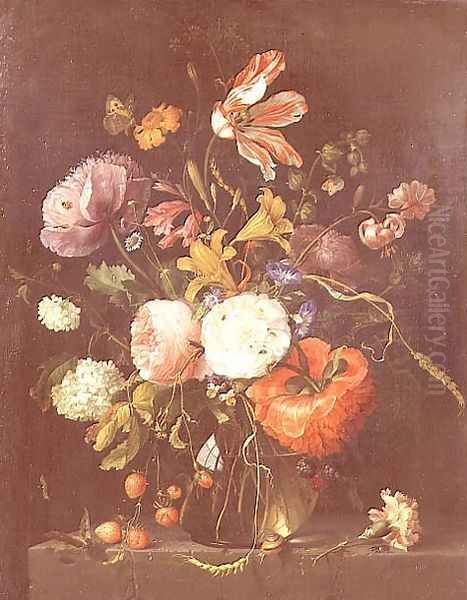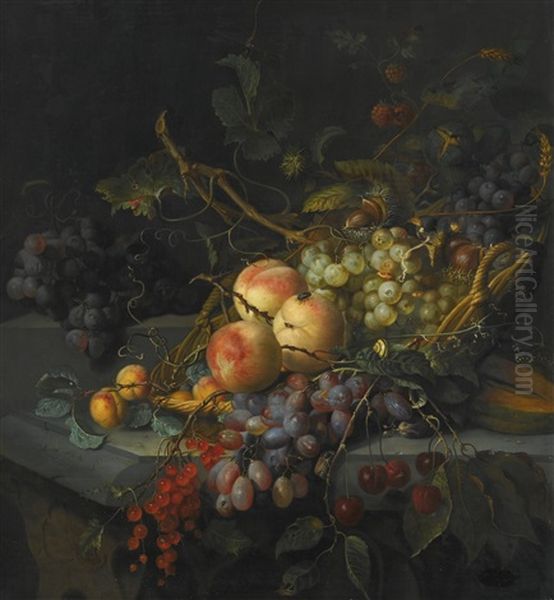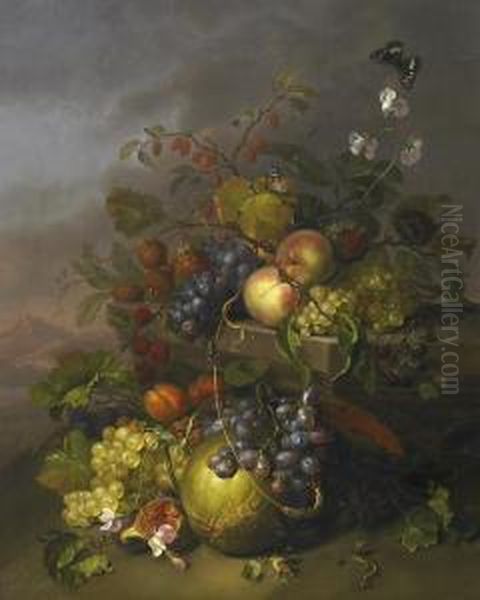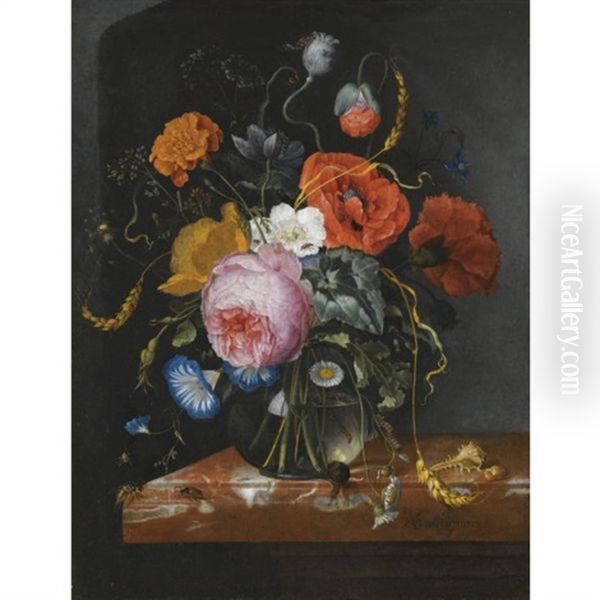Jacob van Walscapelle stands as a significant, if sometimes overlooked, figure in the rich tapestry of Dutch Golden Age painting. Active during a period of unprecedented artistic flourishing, Walscapelle carved a niche for himself as a master of still life, particularly renowned for his exquisite depictions of flowers and fruit. His works, characterized by meticulous detail, subtle lighting, and often profound symbolism, offer a captivating window into the aesthetic sensibilities and intellectual currents of 17th and early 18th-century Holland.
From Cruydenier to Walscapelle: Early Life and Artistic Beginnings
Born in Dordrecht in 1644, the artist was originally named Jacobus Cruydenier. He later adopted his maternal great-grandfather's surname, Walscapelle, the name under which he achieved artistic recognition. While the specifics of his earliest training in Dordrecht remain somewhat obscure, it is known that he moved to Amsterdam, the bustling heart of the Dutch Republic and its art market.
In Amsterdam, Walscapelle's artistic development was significantly shaped by his tutelage under Cornelis Kick (c. 1631/34–1681). Kick was himself a respected painter of still lifes, particularly flowers, and his influence is discernible in Walscapelle's early works, which demonstrate a careful attention to botanical accuracy and a delicate touch. This foundational training provided Walscapelle with the technical skills necessary to excel in a genre that demanded both precision and artistry.
Following Kick's death in 1681, or perhaps even before, Walscapelle's style evolved further, absorbing influences from other leading still life painters of the era. Among the most prominent was Jan Davidsz. de Heem (1606–1684), a towering figure in Dutch and Flemish still life painting. De Heem was celebrated for his opulent arrangements, rich colors, and masterful rendering of textures. Walscapelle clearly studied de Heem's approach to composition, his ability to create a sense of abundance, and his skill in balancing complex arrays of objects. While Walscapelle's works often possess a more intimate scale than de Heem's grand pronkstillevens (ostentatious still lifes), the older master's impact on his sophisticated arrangements and luminous surfaces is undeniable.
The Dutch Golden Age: A Crucible for Artistic Innovation

To fully appreciate Jacob van Walscapelle's contribution, it is essential to understand the extraordinary artistic environment in which he worked. The 17th century in the Netherlands, often termed the Dutch Golden Age, was a period of remarkable economic prosperity, scientific advancement, and cultural achievement. Having thrown off Spanish rule and established an independent republic, the Dutch nation experienced a surge in trade and wealth, leading to the rise of a prosperous merchant class.
This new bourgeoisie became avid patrons of the arts. Unlike in many other parts of Europe where art was primarily commissioned by the Church or aristocracy, in the Netherlands, a broader segment of society sought paintings to adorn their homes. This led to a diversification of subject matter. While religious themes did not disappear entirely, especially after the iconoclastic phases of the Reformation, there was a burgeoning demand for secular genres: portraits, landscapes, scenes of everyday life (genre painting), marine paintings, and, crucially for Walscapelle, still lifes.
Artists like Frans Hals (c. 1582/83–1666) captured the vibrant personalities of the era in his lively portraits. Rembrandt van Rijn (1606–1669) explored profound human emotion and spirituality through biblical scenes, historical subjects, and deeply introspective portraits. Johannes Vermeer (1632–1675) created serene and luminous depictions of domestic interiors, imbued with a quiet poetry. The Dutch artistic landscape was incredibly varied, with painters often specializing in particular niches.
Still life painting, in particular, reached unprecedented heights of popularity and sophistication. These works appealed to the Dutch appreciation for meticulous craftsmanship and their interest in the tangible world. Flowers, fruit, tableware, and other objects were rendered with astonishing realism, celebrating both the beauty of nature and the products of Dutch trade and industry. Beyond their surface appeal, still lifes often carried deeper symbolic meanings, reflecting on themes of wealth, transience, and morality.
Walscapelle's Artistic Style: Precision, Light, and Elegance
Jacob van Walscapelle developed a distinctive artistic style characterized by several key features that set his work apart, even within the highly competitive field of Dutch still life painting.
Meticulous Detail and Illusionistic Realism

A hallmark of Walscapelle's art is his extraordinary attention to detail. He rendered the delicate veins of a petal, the fuzzy skin of a peach, the glistening dewdrop on a leaf, or the intricate patterns on an insect's wing with almost microscopic precision. This commitment to realism was a defining characteristic of the Leiden 'fijnschilders' (fine painters) like Gerrit Dou, and while Walscapelle was not strictly of this school, his work shares their dedication to verisimilitude. His ability to capture the varied textures of different objects – the smoothness of glass, the softness of velvet, the roughness of a lemon peel – was remarkable, creating a powerful illusion of reality that invited close inspection.
Subtle Handling of Light and Shadow
Walscapelle was a master of chiaroscuro, the use of strong contrasts between light and dark, to model forms and create a sense of volume and depth. However, his application of light was often more subtle and diffused than that of some of his contemporaries who favored more dramatic, Caravaggesque lighting. He frequently employed a soft, directional light that would gently illuminate his subjects, highlighting their colors and textures while allowing for gentle gradations into shadow. This nuanced handling of light contributed to the serene and harmonious atmosphere that pervades many of his paintings. The way light catches the translucent skin of a grape or reflects off a polished surface is a testament to his observational skills.
Balanced and Elegant Compositions
Though his paintings often feature a multitude of elements, Walscapelle's compositions are typically characterized by a sense of balance and elegance. He arranged his flowers, fruits, and accompanying objects with a careful eye for harmony, creating dynamic yet stable arrangements. Whether a dense bouquet spilling from a vase or a carefully curated selection of fruits on a stone ledge, his compositions guide the viewer's eye through the painting in a deliberate and pleasing manner. He often utilized diagonal lines or S-curves to impart a sense of movement and grace to his arrangements, a technique also masterfully employed by artists like Willem van Aelst (1627–1683), known for his sophisticated and dynamic still lifes.
Rich and Harmonious Color Palette
Walscapelle's palette was rich and varied, yet always harmonious. He captured the vibrant hues of tulips, roses, and irises, the deep reds of cherries, and the golden yellows of lemons with remarkable fidelity. His colors are luminous and saturated, contributing to the overall richness of his paintings. He skillfully balanced warm and cool tones, creating a sense of visual coherence even in complex arrangements featuring a wide array of colors. This sensitivity to color relationships is a key element of the enduring appeal of his work.
Thematic Depths: Symbolism in Walscapelle's Still Lifes

Beyond their aesthetic beauty, Jacob van Walscapelle's still lifes, like those of many of his Dutch contemporaries, are often rich in symbolic meaning. The 17th-century viewer would have been adept at reading these visual cues, which added layers of intellectual and moral significance to the paintings.
Vanitas and the Transience of Life
One of the most prevalent themes in Dutch still life painting was vanitas, a meditation on the fleeting nature of earthly pleasures and the inevitability of death. Walscapelle frequently incorporated elements that alluded to this theme. Flowers, beautiful in their prime, would inevitably wilt and fade, symbolizing the brevity of life and beauty. The inclusion of insects like butterflies (symbolizing the soul or resurrection, but also ephemerality) or flies (symbols of decay) further reinforced this message. Sometimes, a piece of fruit might show signs of overripeness or decay, serving as a memento mori – a reminder of mortality. These vanitas elements encouraged viewers to reflect on spiritual matters rather than becoming overly attached to worldly possessions. Artists like Harmen Steenwijck specialized in overt vanitas still lifes, often including skulls and hourglasses, but the theme was subtly woven into many floral and fruit pieces as well.
The Celebration of Nature's Bounty and Divine Creation
While acknowledging life's transience, Walscapelle's paintings also celebrate the beauty and abundance of the natural world. The meticulously rendered flowers and fruits can be seen as a testament to God's creation. In an era of burgeoning scientific inquiry and exploration, there was a keen interest in the diversity of flora and fauna. Exotic flowers like tulips, which had famously caused "Tulip Mania" earlier in the century, were prized for their beauty and rarity. The depiction of these natural wonders could evoke a sense of awe and appreciation for the richness of the created world. This aspect aligns with the work of earlier pioneers of floral still life, such as Ambrosius Bosschaert the Elder (1573–1621) and Balthasar van der Ast (1593/94–1657), whose works meticulously cataloged floral diversity.
Implied Sensual and Moral Messages

Certain fruits and flowers carried specific connotations. Grapes, for instance, could allude to wine and, by extension, to Christ and the Eucharist, or more secularly, to pleasure. Peaches might symbolize truth or virtue. The careful selection and arrangement of these elements could convey subtle moral or philosophical messages to the discerning viewer. The presence of small creatures, such as snails (symbolizing slowness or sin) or caterpillars (symbolizing transformation), added further layers of meaning. Otto Marseus van Schrieck (c. 1619–1678) specialized in "sottobosco" or forest-floor still lifes, often featuring such creatures amidst dark foliage, highlighting the wilder, less cultivated aspects of nature, and Walscapelle sometimes incorporated similar elements with precision.
A Closer Look at Key Works by Jacob van Walscapelle
Jacob van Walscapelle's oeuvre, though not as extensive as that of some of his contemporaries due to his other civic duties, includes several masterpieces that exemplify his skill and artistic vision.
This work, reportedly held at the Royal Museum of Fine Arts Antwerp (Inventory No. 54), is a quintessential example of Walscapelle's floral still lifes. One can expect a vibrant assembly of different flower species, each rendered with botanical accuracy. The inclusion of various insects – butterflies, beetles, perhaps a caterpillar or a fly – would not only add to the painting's realism but also introduce symbolic undertones of life, death, and transformation. The interplay of light on the petals and leaves, and the careful arrangement of the bouquet to create a sense of depth and naturalness, would be characteristic of his style. Such paintings were highly prized for their decorative qualities and their underlying moral messages.
Flowers in a Glass Vase (c. 1670)
Now housed in the Los Angeles County Museum of Art (LACMA), this painting, dated around 1670, showcases Walscapelle's mastery in depicting flowers within a transparent glass vase. The challenge of rendering glass, with its reflections and refractions, was one that Dutch still life painters relished. Walscapelle would have expertly captured the way the stems are distorted by the water and the play of light on the vase's surface. The bouquet itself would likely feature a variety of blooms, possibly from different seasons – a common practice in Dutch floral painting, achieved by working from individual studies made throughout the year. This allowed artists to create idealized arrangements that surpassed what nature could offer at any single moment. The composition would be carefully balanced, with flowers at various stages of bloom, perhaps hinting at the vanitas theme.
Still Life with Fruit

A work titled Still Life with Fruit, featuring grapes, chestnuts, and a melon, is part of the collection at the John and Mable Ringling Museum of Art, Florida State University. This painting would highlight Walscapelle's skill in rendering different textures: the smooth, translucent skin of grapes, the prickly husk and polished surface of chestnuts, and the rough rind of a melon. The arrangement would likely be on a stone ledge or table, a common setting for such still lifes. The play of light on these varied surfaces, and the rich, earthy tones of the fruits, would create a sense of tactile realism. Such fruit pieces celebrated nature's bounty and often carried symbolic meanings related to abundance, fertility, or, if showing signs of decay, the transience of earthly pleasures. Another Still Life with Fruit, depicting apples and cherries among other items, is noted as being in the National Gallery of Art, Washington D.C., demonstrating his recurring engagement with this subject.
Bouquet of Tulips
Located in the Kremlin Armoury Museum, Moscow, a Bouquet of Tulips by Walscapelle would pay homage to one of the most iconic flowers of the Dutch Golden Age. Tulips, with their vibrant colors and varied forms, were a favorite subject for artists. Walscapelle would have depicted them with his characteristic precision, capturing the subtle striations and velvety texture of their petals. The composition might feature tulips in different stages of bloom, arranged in a way that emphasizes their stately elegance. Given the historical context of "Tulip Mania," a painting focused on tulips could also subtly allude to themes of speculation, wealth, and the ephemeral nature of worldly fads. The earlier attribution of a 1641 date to such a work is problematic given his birth year, suggesting either a misattribution or a later creation date.
A Garland of Flowers and Fruit with a Snail and Butterflies (also known as Les Guirlandes)
This painting, in the collection of the Matzo Paris Art Fund, exemplifies another popular subgenre of still life: the garland painting. Pioneered by artists like Jan Brueghel the Elder (1568–1625) and Daniel Seghers (1590–1661), garland paintings often featured swags or wreaths of flowers and fruit, sometimes surrounding a central cartouche that might contain a religious scene, a portrait, or a landscape. Walscapelle's version would showcase his ability to create a lush, decorative arrangement, with flowers and fruits intertwined. The inclusion of a snail and butterflies would add to the naturalism and symbolic complexity, touching upon themes of earthly existence, the soul, and the passage of time.

A particularly notable work, often cited as a pinnacle of his achievement, is a Still Life with Fruit dated 1675. This piece is lauded for its exquisite detail, the masterful rendering of light and texture, and its potent symbolic content. The fruits, including grapes, peaches, and apricots, are arranged with a dynamic sense of balance, some seemingly on the verge of tumbling from the stone ledge. This precariousness, combined with the lusciousness of the fruit, powerfully evokes the vanitas theme – the beauty and pleasure of the world are fleeting, and death and decay are ever-present.
Contemporaries and the Broader Still Life Tradition
Jacob van Walscapelle worked within a vibrant community of still life painters. His direct mentors, Cornelis Kick and Jan Davidsz. de Heem, were pivotal. De Heem, in particular, with his Antwerp roots and later activity in Utrecht and Amsterdam, was a conduit for both Flemish opulence and Dutch precision.
Walscapelle was also undoubtedly aware of the work of other Utrecht still life painters, such as Abraham Mignon (1640–1679), a German-born artist who studied with Jan Davidsz. de Heem and became known for his highly detailed and often dramatically lit floral pieces and forest floor scenes. Mignon's meticulousness and rich coloration share affinities with Walscapelle's approach.
Other prominent still life artists of the period whose work provides context for Walscapelle's include Willem Kalf (1619–1693), renowned for his sumptuous "pronkstillevens" featuring precious objects like Chinese porcelain, silverware, and Turkish carpets, often with a strong emphasis on the play of light on reflective surfaces. Rachel Ruysch (1664–1750), one of the most successful female painters of the era, created exceptionally delicate and dynamic floral still lifes, often with a sense of movement and asymmetry that distinguished her work. Her career overlapped significantly with Walscapelle's later period.
The tradition Walscapelle inherited was rich and varied. Early 17th-century masters like Ambrosius Bosschaert the Elder and Balthasar van der Ast had established the conventions of the floral bouquet, characterized by bright, even lighting and a meticulous, almost encyclopedic depiction of individual blooms. Later artists, including Walscapelle, built upon this foundation, introducing more complex lighting, richer textures, and often deeper symbolic content.
A Life Beyond the Easel: Civic Duties
Interestingly, Jacob van Walscapelle's life was not solely dedicated to his art. Records indicate that he also held civic positions in Amsterdam. He is documented as having worked as a clerk for the municipal cloth hall (Lakenhal). Furthermore, in 1673, he reportedly became an official at the Amsterdam City Hall (Stadhuis, now the Royal Palace on Dam Square).
These civic responsibilities may account for his relatively modest surviving oeuvre compared to some full-time painters. Balancing artistic pursuits with official duties would have been demanding. However, his involvement in municipal affairs also suggests a respected standing within the Amsterdam community. There is even some speculation that he might have occasionally been involved in architectural painting, though he remains overwhelmingly known for his still lifes. His marriage to Anthonia van Walscapelle (who had previously been married to the painter Absalon Ottor Ellegher) further connected him to the artistic and social fabric of the city.
Legacy and Enduring Appeal
Jacob van Walscapelle's paintings continued to be appreciated after his death in Amsterdam in 1727. His works found their way into significant collections, and his reputation as a skilled still life painter endured. While perhaps not achieving the widespread fame of a Rembrandt or Vermeer, or even the very top tier of still life specialists like de Heem or Kalf in popular recognition, Walscapelle holds a secure place in the annals of Dutch art.
His paintings are admired today for their technical brilliance, their aesthetic beauty, and the fascinating glimpse they offer into the cultural preoccupations of the Dutch Golden Age. The meticulous detail invites sustained looking, revealing new subtleties with each viewing. The symbolic content, while perhaps not always immediately apparent to the modern eye, adds a layer of intellectual depth that enriches the viewing experience. Museums around the world, including the National Gallery in London (which holds a Flowers in a Glass Vase distinct from the LACMA piece, showcasing his variations on themes), the Rijksmuseum in Amsterdam, and those mentioned earlier, proudly display his works.
In an era that produced an astonishing number of talented artists, Jacob van Walscapelle distinguished himself through his refined sensibility, his mastery of light and texture, and his ability to imbue everyday objects with both beauty and meaning. His floral and fruit still lifes are more than mere depictions; they are carefully constructed meditations on nature, time, and the human condition, rendered with a luminous touch that continues to captivate. His contribution to the Dutch Golden Age, particularly within the specialized and highly refined genre of still life, remains a testament to his considerable talent and enduring artistry.